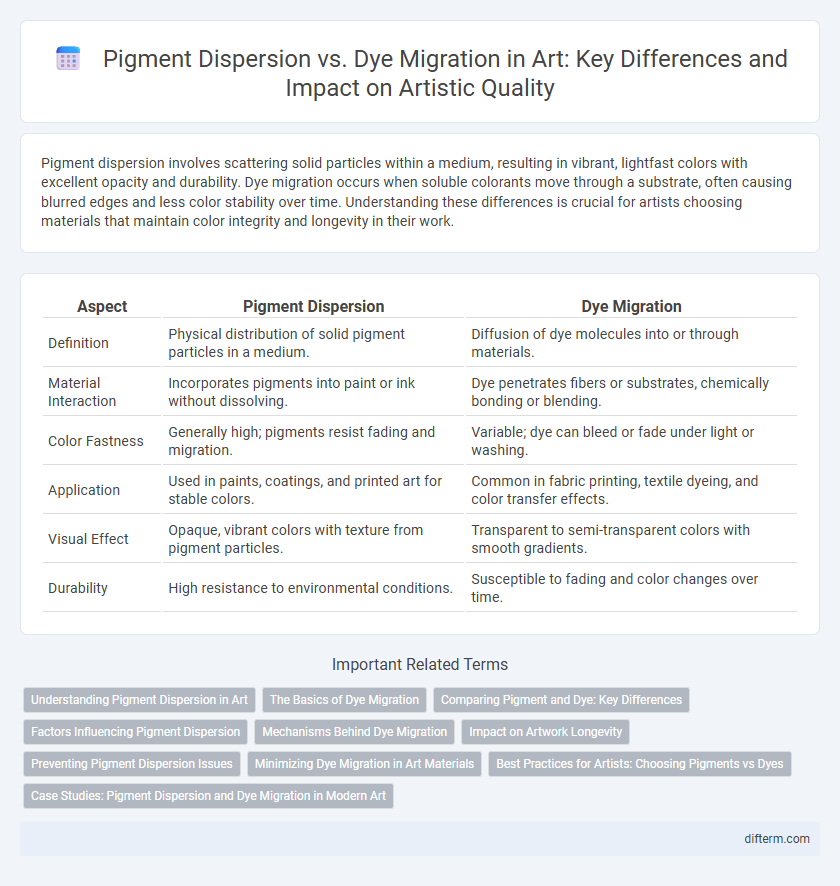Pigment dispersion involves scattering solid particles within a medium, resulting in vibrant, lightfast colors with excellent opacity and durability. Dye migration occurs when soluble colorants move through a substrate, often causing blurred edges and less color stability over time. Understanding these differences is crucial for artists choosing materials that maintain color integrity and longevity in their work.
Table of Comparison
| Aspect | Pigment Dispersion | Dye Migration |
|---|---|---|
| Definition | Physical distribution of solid pigment particles in a medium. | Diffusion of dye molecules into or through materials. |
| Material Interaction | Incorporates pigments into paint or ink without dissolving. | Dye penetrates fibers or substrates, chemically bonding or blending. |
| Color Fastness | Generally high; pigments resist fading and migration. | Variable; dye can bleed or fade under light or washing. |
| Application | Used in paints, coatings, and printed art for stable colors. | Common in fabric printing, textile dyeing, and color transfer effects. |
| Visual Effect | Opaque, vibrant colors with texture from pigment particles. | Transparent to semi-transparent colors with smooth gradients. |
| Durability | High resistance to environmental conditions. | Susceptible to fading and color changes over time. |
Understanding Pigment Dispersion in Art
Pigment dispersion in art refers to the even distribution of pigment particles within a medium, ensuring consistent color intensity and stability over time. Proper dispersion prevents clumping and uneven drying, which can affect the artwork's texture and vibrancy. Unlike dye migration, which involves color bleeding or fading through fabric or paper, well-dispersed pigments maintain sharp edges and long-lasting color fidelity in paintings and prints.
The Basics of Dye Migration
Dye migration occurs when soluble dyes move from one area of an artwork to another, often causing colors to blur or alter the intended design. Unlike pigment dispersion, which involves the physical scattering of solid particles, dye migration results from the chemical diffusion of dyes within materials such as fabrics or paper. Controlling environmental factors like humidity and temperature is essential to minimize dye migration and preserve the original color integrity of the artwork.
Comparing Pigment and Dye: Key Differences
Pigments consist of solid particles that remain suspended in a medium, providing opacity and lightfastness, whereas dyes dissolve completely, resulting in vivid colors but less durability. Pigments are typically more resistant to fading and washing, making them ideal for long-lasting artworks; dyes, however, offer brighter hues but tend to migrate and bleed over time. Understanding the molecular structure differences between pigment particles and dye molecules is crucial for artists selecting materials based on their desired permanence and color intensity.
Factors Influencing Pigment Dispersion
Factors influencing pigment dispersion in art include particle size, surface chemistry, and the choice of dispersing agents, all of which affect color intensity and stability. Proper milling and mixing techniques help achieve uniform pigment distribution, enhancing the vibrancy and durability of the artwork. Environmental conditions such as temperature and pH also play a significant role in preventing agglomeration and promoting consistent pigment performance.
Mechanisms Behind Dye Migration
Dye migration occurs when dye molecules move from one area of an artwork to another due to molecular diffusion, influenced by temperature, humidity, and solvent interactions. This process differs from pigment dispersion, which relies on the mechanical distribution of solid pigment particles within a binder matrix. Understanding the chemical affinity and solvent polarity is essential to control dye migration in textile art and printmaking.
Impact on Artwork Longevity
Pigment dispersion results in more stable color retention as pigments consist of finely ground particles that remain suspended in a medium, reducing the risk of fading or color bleeding over time. Dye migration occurs when dyes dissolve and move through substrates, causing colors to blur and degrade the artwork's clarity and vibrancy faster. This difference significantly impacts artwork longevity by influencing colorfastness and the overall preservation of the piece.
Preventing Pigment Dispersion Issues
To prevent pigment dispersion issues in artworks, artists should choose high-quality, finely milled pigments that ensure even distribution and minimize clumping. Proper binder selection and thorough mixing techniques enhance pigment adhesion and reduce the risk of migration during application and drying. Maintaining controlled environmental conditions, such as stable humidity and temperature, further prevents pigment separation and color inconsistencies.
Minimizing Dye Migration in Art Materials
Minimizing dye migration in art materials involves selecting pigments with high lightfastness and stability to prevent color bleeding over time. Using synthetic pigments and incorporating fixatives or binders can reduce the tendency of dyes to migrate into adjacent layers or substrates. Proper storage conditions, such as controlling humidity and temperature, further contribute to preserving the integrity of pigment dispersion and preventing unwanted color shifts in artworks.
Best Practices for Artists: Choosing Pigments vs Dyes
Selecting pigments over dyes ensures greater colorfastness and longevity, as pigments are insoluble particles that resist fading and bleeding, essential for archival-quality artworks. Artists seeking vibrant and lightfast results should prioritize high-quality inorganic or organic pigments, which maintain stability in various media and environmental conditions. Understanding the molecular structure difference helps artists avoid dye migration, preventing unwanted color blending and preserving the integrity of multilayered compositions.
Case Studies: Pigment Dispersion and Dye Migration in Modern Art
Case studies in modern art reveal that pigment dispersion ensures long-lasting color stability by embedding color particles within the paint matrix, preventing fading and bleeding. Dye migration, conversely, often causes color bleeding and loss of vibrancy over time due to the dye's solubility and movement through fabric or coatings. Understanding these differences guides artists and conservators in selecting materials for enhanced durability and visual integrity in contemporary artworks.
pigment dispersion vs dye migration Infographic

 difterm.com
difterm.com